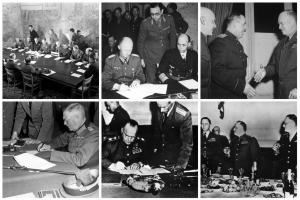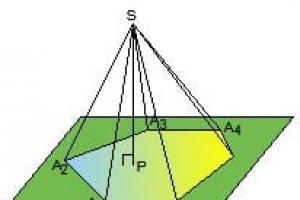Books in the “Unknown Rus'” series from the Veche publishing house

The series has been published since 2012 and currently has more than 50 editions.
The books in the series are dedicated to little-known and unexplored pages of the history of pre-Christian Rus'. Secrets of ancient migrations, mysterious cults of the Slavs, the origin of the Russian state, the mysteries of the “Vlesova (Veles) Book”, the secrets of ancient pre-Cyrillic writing, the origin of the Cossacks
- these and many other topics are touched upon by the authors of the series.
Books are arranged in chronological order as they are published. Within a year - in alphabetical order of authors and book titles.

Lesnoy, S. History of the Russians: Varangians and Russian statehood / Sergey Lesnoy. – Moscow: Veche, 2012. – 368 p. – (Unknown Rus').
The work of the famous researcher of the history of Ancient Rus' S. Lesny (S. Ya. Paramonov) is devoted to the issues of the origin of the Russian state and its culture, the formation of Kievan Rus and the emergence of Novgorod Rus, the origins of the Slavic community, language and statehood. The author believes that statehood in Rus' was sufficiently developed, with the Rurikovichs it was not statehood that appeared, but a new dynasty that united two significant Slavic states: Novgorod and Kiev, but which immediately became glorified.

Seryakov, M. L. The Great Law of the Slavs / Mikhail Seryakov. – Moscow: Veche, 2012. – 317, p. – (Unknown Rus').
At that distant time, when the ancient Indo-Europeans began to perceive the world around them as a coherent system, they began to determine a place in it for themselves and their society. Understanding the Universe as the embodiment of harmony and unity, opposite to chaos, the Indo-Europeans believed that this order was necessarily governed by a Single Law, moving the entire universe, and with it gods and people. It is extremely difficult for modern man to imagine this comprehensive pagan principle. The great spiritual impulse was so enormous that the light of truth shone for many centuries and even continued its influence after the collapse of the Indo-European unity, when individual peoples of the great linguistic family settled across a good half of Europe.

Seryakov, M. L. Dazhbog, ancestor of the Slavs / Mikhail Seryakov. – Moscow: Veche, 2012. – 479 pp.: ill. – (Unknown Rus').
Our distant ancestors already had a myth at the dawn of history, and this myth was so comprehensive that it permeated almost all aspects of material and spiritual life and ultimately formed a unique worldview. This myth was about Dazhbog and the origin of the great tribe of Slavs from him. Our ancestors firmly knew how and why they were born on Earth, what their true essence and true purpose were. Myth gave them a holistic system of perception of the world and indicated the direction of movement, filling life with higher meaning. In terms of its significance, the solar myth can be called the main one in the religion of the Slavs. In the next book in the series, readers are offered the author's reconstruction of the myth of Dazhbog, its place in the religious and everyday life of the Slavs. Based on extensive material, the author tries, sometimes controversially and sharply polemically, to rethink the thousand-year history of Rus' after the adoption of Christianity. The book is published in the author's edition.

Vorontsov, A.V. The unknown history of the Russian people. The mystery of the Grafenstein inscription: / Andrey Vorontsov. – Moscow: Veche, 2013. – 285, p. : ill. – (Unknown Rus').
The author, based on the latest discoveries in archaeology, anthropology, genetics and linguistics, tries to reconstruct the history of our ancestors until the 9th century AD. The book talks about a stone found in 1977 in the Austrian town of Grafenstein with fragments of an inscription from the 2nd century. n. e., which belonged to the Noriks. The Noriki, according to the testimony of Nestor, the chronicler in The Tale of Bygone Years, were the direct ancestors of the Eastern Slavs. According to historians of Ancient Rome, the Norics existed at least a thousand years before the Slavs, according to the dominant “German historical school” in Europe, appeared on the continent. The author proves direct continuity between the Old Russian and Paleo-Venetian cultures.

Golubovsky, P.V. Pechenegs, Torci and Cumans: Rus' and the Steppe before the Tatar invasion: / Peter Golubovsky. – Moscow: Veche, 2013. – 300, p. : ill. – (Unknown Rus').
At the end of the 10th - in the middle of the 11th century, tribes of nomads - Pechenegs, Torks and Polovtsians - invaded the borders of Ancient Rus'. They changed the course of the historical life of Rus' and the entire Eastern Slavs and had a significant influence on their future destinies. For several centuries, Rus' not only fought with the steppe inhabitants, but also founded military-political alliances with them. In his book, the famous Russian historian Pyotr Vasilyevich Golubovsky tells how much and how the neighborhood of nomads influenced the political life of Ancient Rus', what were the relations between the Turks and Slavs. Based on important Russian, Byzantine and Arabic sources, the scientist also talks about the mutual tribal kinship and tribal origin of the Pechenegs, Torks and Cumans. The book is published with slight abbreviations, preserving the peculiarities of 19th-century punctuation spelling.

Niederle, L. Life and culture of the ancient Slavs: / Lyubor Niederle. – Moscow: Veche, 2013. – 284, p. : ill. – (Unknown Rus').
Lubor Niederle (1865–1944) is a famous Czech archaeologist and Slavic historian, author of the fundamental work “Humanity in Prehistoric Times,” which outlines the archeology of all of Europe from the Paleolithic to the Middle Ages inclusive. Besides. Peru Niederle owns a multi-volume work “Slavic Antiquities”, the second part of which - “Life and Culture of the Ancient Slavs” - is presented in this book. Based on carefully studied objects of material culture and using data from history, philology, ethnography, and anthropology, Niederle created a genuine encyclopedia of the history and culture of the ancient Slavs, a work distinguished by high scientific rigor and objectivity.

Peresvet, A. A. Russians - conquerors of the Slavs: / Alexander Peresvet. - Moscow: Veche, 2013. - 431 p. : ill. - (Unknown Rus'). - Bibliography: p. 357-393.
Who are the Russians? Where did they come from? How did they manage to conquer numerous Slavic tribes? The historian A. Peresvet is trying to answer these questions.

Russian legends / [comp. I. N. Kuznetsov]. – Moscow: Veche, 2013. – 398, p. : ill., portrait – (Unknown Rus'). - Bibliography: p. 386-388.
The book presents Russian folk tales and legends collected by famous writers, journalists and folklorists of the 19th century about the creation of the Earth, Thunder-rattlers, sun maidens, the Berendey Forest, about student keys, heroic paths, about fortune-telling at Christmas time and Kupala night, about the fern flower and treasured treasures, about Martha the Posadnitsa, Stenka Razin, the magician Bruce and many others.

Savelyev, E.P. Ancient history of the Cossacks / Evgraf Savelyev. - Moscow: Veche, 2013. - 445, p. - (Unknown Rus').
Who are the Cossacks? Descendants of runaway serfs, one of the classes of old Russia, as academic science usually claims? Or did their ancestors (at least some of them) from time immemorial live in the same regions - on the Don, in the Kuban?... This is precisely the position taken by the author of this book - Cossack historian, writer and local historian Evgraf Petrovich Savelyev. Drawing on a colossal amount of factual material, with the passion and conviction of a true patriot, he proves that the culture of the Cossacks in many of its manifestations goes back thousands of years, that the Cossacks are not random strangers on their land.

Seryakov, M. L. “The Pigeon Book” - a sacred legend of the Russian people: / Mikhail Seryakov. - Moscow. : Veche, 2013. - 445, p. : ill., table. - (Unknown Rus'). - Bibliography in note: p. 409-446.
The book is dedicated to the origins of the worldview of the Russian people, which developed in the pagan era. One of its most striking manifestations is the “Pigeon Book” - the sacred legend of our distant ancestors, in which they expressed their idea of the origin of the Universe and man. The core of this ancient work of Russian spiritual culture was formed at least 5,000 years ago. For the first time in Russian historiography, the Slavs’ idea of the universal law, which developed back in the era of the Indo-European community, is examined.

Seryakov, M. L. Spiritual ancestral home of the Slavs: / Mikhail Seryakov. – Moscow: Veche, 2013. – 446, p. : ill. – (Unknown Rus').
It is simply impossible to describe the spiritual origins of any people, and especially the Russian one, in one work. Therefore, the author tried, first of all, to trace the earliest spiritual origins of our people, and set out to reveal its true spiritual roots and look into the distant historical era of pagan Rus'. Moreover, for more than one century it has attracted the attention of researchers who have studied it from the point of view of political history, archeology, culture, religion, linguistics, and economics. And yet, until now there have been no serious attempts to find out those spiritual root causes that ultimately made Russians Russians and once and for all set the vector of development for the people.
The author tries to answer such important questions - where and when did the community of people to which we belong first originate? Who were our most ancient ancestors? How to restore the earliest period of their history and, knowing the starting point, trace their further development up to the era from which reliable written and archaeological evidence remains? Where can I find the territory where the Russian people were born?

Seryakov, M. L. The cult of the sun among the ancient Slavs / Mikhail Seryakov. – Moscow: Veche, 2013. – 303 p. : ill. – (Unknown Rus').
The book by the famous researcher of Slavic paganism M.L. Seryakov is dedicated to the cult of the sun among our distant ancestors and, to a certain extent, is a continuation of his work “Dazhbog - the progenitor of the Slavs.” Among the Slavs, the sun was one of the main objects of worship. On the eve of baptism in the pantheon of Vladimir 980. ancient chronicles ancient chronicles even record two solar deities - Khors and Dazhbog, occupying second and third place after the supreme thunderer Perun. According to many researchers, Khors was borrowed from their southern Iranian-speaking neighbors and is an example of Scythian religious influence on the beliefs of our distant ancestors. Dazhbog, according to “The Tale of Igor’s Campaign,” was the ancestor of either only Russian princes or the entire Russian people. The author is convinced that the great solar myth was not just one abstract idea. Over the centuries, he has manifested himself in a variety of ways in the life of our distant ancestors, being its spiritual core.

Gudz-Markov, A.V. Indo-Europeans of Eurasia and the Slavs: / Alexey Gudz - Markov. – Moscow: Veche, 2014. – 445, p. : ill., table. – (Unknown Rus').
The strength of the Slavs, the resilience and power of their language, the depth of culture and the middle position on the continent stem from the Slavs’ perception of most of the major cultural and ethical phenomena that took place in Eurasia during the 5th millennium BC. e. – II millennium AD e. The Slavs accepted and absorbed not only the many migrations of Indo-European nomads who went to Europe from the steppes of Central Asia, Southern Siberia, the Urals, from the lower reaches of the Volga, Don, and Dnieper. The Slavs were the immediate successors of the great archaeological cultures of the settled Indo-European population of the center and east of Europe, including the lands of historical Rus'. The apparent pliability and pliability of the Slavs, their tolerance towards other cultures and peoples is the fruit of millennia, an unceasing series of clashes and victories of the Slavs over the conquerors invading their midst. The innate breadth and melodiousness of Slavic nature, its recklessness and sometimes borderless prowess are also the result of the Slavs’ awareness of the enormity of their lands, the inexhaustibility and vastness of their wealth.

Maksimov, S. G. Magi, buffoons and ophens: / Sergey Maksimov. - Moscow: Veche, 2014. - 318, p. : ill. - (Unknown Rus'). - Lit.: p. 300-317.
The question of the origin of the Magi, buffoons, ofeni and their contribution to ancient Russian culture is still poorly understood, and therefore, in the author’s opinion, it requires special attention from researchers. In his new book, S. Maksimov, relying on the research of domestic historians, religious scholars, philologists and cultural experts, talks about the Magi and witchcraft, about the origin, history, ritual traditions of buffoons, bearers of ancient priestly knowledge, about ophenism - a traveling trade that flourished briskly after the ban buffoonery. The author traces the path of witchcraft from the Magi through buffoons and ophens to the underworld and to modern paganism, which is trying to restore that elemental-natural that still lives in man.

Alekseev, S. V. Great settlement of the Slavs, 672 - 679. / Sergey Alekseev. – Moscow: Veche, 2015. – 317, p. – (Unknown Rus').
In 602, a new historical period begins for the Slavic tribes and for all of Eastern Europe. Having broken through the border of the weakened Byzantine Empire, torn apart by internal turmoil, the Slavs settled widely throughout its territories, not only European ones. At the same time, the flows of Slavic colonization, long held back by state and tribal borders, rush to the north - to the Baltic along its entire length. In the east, the Slavs penetrate deeper into the forest-steppe and forest lands along the borders of the Turkic steppes. As a result of all these events, Slavic Europe from a relatively small collection of tribal territories turns into the Slavic World known to us today. Its borders already in the second half of the 7th century extended from the southern tip of the Peloponnese to Lake Ladoga, from the upper reaches of the Don to the Rhine Basin.

Alekseev, S.V. The Baptism of Rus' and Saint Vladimir / Sergey Alekseev. – Moscow: Veche, 2015. – 317, p. – (Unknown Rus').
For centuries, the Russian people remembered the Kyiv prince Vladimir Svyatoslavich. I remembered the “affectionate one”, I remembered the “Red Sun”, chanting the generosity of the feasts and the splendor of the heroic court. Less than six centuries after his reign, the loud patronymic of the prince was replaced in the people's memory by another, probably more meaningful one - “Vseslavich”. Above all, the Russian Church glorified Vladimir on earth, adding with its power, but not with its own will, one must think, to the name of the Baptist of Rus' not a nickname, but something more - Saint. The Baptism of Rus' is a turning point in its entire history, with which even its ill-wishers agree. And Vladimir’s name rightly turned out to be forever associated with this greatest event. The list of Vladimir’s state victories is long, but his main victory was the victory over himself, over the past in himself. The book by the historian Alekseev will help the reader discover a new, more lively image of the Grand Duke.

Alekseev, S. V. Slavs and Avars. Second half of the 6th – beginning of the 7th century / Sergey Alekseev. – Moscow: Veche, 2015. – 255 p. – (Unknown Rus').
The book by historian S.V. Alekseev is dedicated to the little-studied war of the Antes and other Slavic tribes with the Avars, a nomadic people of Central Asian origin. For the Slavs, its outcome was sad. And yet, despite the defeat, not all the Ants were conquered. The aliens formed the Avar Kaganate in Central Europe - a powerful state headed by a sovereign - the Kagan. Some of the Slavic tribes were involved by the new conquerors in campaigns against Byzantium in the role of dependent allies. However, individual Slavic tribes in the western part of the Black Sea region were enslaved. They paid tribute, amounting to half the harvest, and suffered cruelly from the violence of the conquerors. Folk legends preserve information about the cruelty of the Avars towards the Slavic union of tribes, called the Dulebs: the Avars harnessed Duleb women to carts instead of oxen or horses. The answer was the continuous war of the Slavs with their oppressors. Their resistance undermined the strength of the Avar Kaganate and became an important reason for its gradual decline and death in the 8th century.

Alekseev, S. V. Slavs on the threshold of civilization, 679 – 800. / Sergey Alekseev. – Moscow: Veche, 2015. – 352 p. – (Unknown Rus').
The book by historian S. Alekseev is dedicated to one of the most difficult and intense periods in the history of the European Slavs - the second half of the 7th - 8th centuries. At this time, on the Balkan Peninsula, the Byzantine Empire was waging a series of bloody wars with the young Bulgarian state, in the Eastern Alps, Slavic Horutania was desperately fighting the Avar Khaganate, and far in the east, on the banks of the Dnieper, the princes Kiy, Shchek, Horiv and their sister Lebed founded the city of Kyiv .

Zvyagin, Yu. Yu. The Great Road “from the Varangians to the Greeks”: a thousand-year-old mystery of history / Yuri Zvyagin. - Moscow: Veche, 2015. - 317, p. : cards. - (Unknown Rus').
According to all textbooks, Rus' developed around the great trade route “from the Varangians to the Greeks,” connecting the Baltic Sea with the Black Sea. Through the Neva - Lake Ladoga - Volkhov - Ilmen - Lovat - Dnieper, the Norman-Varangians, who subjugated the Slavs, went from north to south for Byzantine gold and goods... The Tale of Bygone Years keeps the only evidence of this famous route. But did he really exist? Journalist and historian Yu. Zvyagin, based on modern archaeological data, study of the area along the entire proposed route, as well as the results of the Holmgard expedition (1994, 1996), proves that the route “from the Varangians to the Greeks” across all of Rus' is a myth. It was probably created by Russian scribes at a time when the “Varangian” version of the formation of the Russian state was being established, that is, not earlier than the 12th century, and this makes us look differently at the first centuries of Russian history.

Larionov, V. E. Alexander Nevsky and Daniil Galitsky: the birth of the Third Rome: / Vladimir Larionov. - Moscow: Veche, 2015. - 318, p. - (Unknown Rus').
The book offers a fundamentally new look at the personality and deeds of Prince Alexander Nevsky. The author examines the prince simultaneously from the position of secular historiosophy and the Orthodox tradition. The reader will learn about Nevsky's political tactics, his awareness of the world historical processes of that time and, finally, his insight both in matters of building relations with the Golden Horde and the aggressive western neighbors of Rus', and in matters of a spiritual nature, about which little is written not only by secularists , but also church historians. The author pays special attention to a major political figure and commander - Prince Daniil Romanovich and his father, Prince Roman Mstislavich Galitsky. The book reveals a number of important reasons why Prince Daniil did not become a key figure in Russian history.

Seryakov, M. L. Battle of the Varangian Pillars / Mikhail Seryakov. – Moscow: Veche, 2015. – 349, p. – (Unknown Rus').
In Russian historical science, the Varangian, or Norman, question occupies a special place. It is inextricably linked with the question: “How was the Old Russian state founded?”, which worries those who are interested in the past of their Fatherland. Outside of scientific circles, this problem is often reduced to an almost three-hundred-year ongoing dispute, which began in the 18th century, between Normanists and anti-Normanists. M. L. Seryakov, based on a comprehensive analysis of accumulated archival and archaeological material, examines the main arguments of representatives of both historical schools and determines the actual ethnic nature of those called to Rus' in 862. princes and their squads. The book also shows the true reasons for the existence of the Norman theory and the ideological ideas that determine it. The book will be of interest to both historians. So does a wide circle of readers interested in the question of the origin of Russian statehood.
The material was prepared by the head of the subscription service sector
Historical and local history library named after I. I. Vasilyov Efimova Tatyana Nikolaevna.
When a conversation begins about the Scythians, the first thing that comes to mind is not the achievements of this ancient legendary people in art and economic activity, but such concepts as “Scythian war” and “small war”. The Scythians remained invincible for a long time. The wars of the Rostov-Suzdal and Vladimir princes in the 12th century are the most important and dramatic page in the history of Ancient Rus'. It was these wars that had a decisive influence on the future fate of the entire Russian state. After them, Kyiv ceased to be the main political center of the Russian lands. The once united country was divided into several parts: North-Eastern Rus', South-Western Rus' and Southern Rus'. Russian historian Nikolai Pavlovich Barsov (1839-1899) devoted his work to the geography of the initial period of Russian history (IX-XIV centuries), the Slavic peoples, their neighbors, as well as the territories in which they lived and which they settled and developed. The book was first published in Warsaw in 1873. For his extremely valuable contribution to science, St. Petersburg University awarded N.P. Barsov a master's degree in Russian history. He received the Uvarov Prize for this work. The invisible city of the righteous - Kitezh, Kitezh-grad, according to legend, sank under the water of Lake Svetloyar during the days of Batu's invasion. As the legend says, only the righteous and saints can see this city. Only a true believer is worthy of hearing the chime of the Kitezh bells. Until now, many Orthodox Christians go to the Nizhny Novgorod Trans-Volga region to make a pilgrimage to the shores of the holy lake. In 602, a new historical period begins for the Slavic tribes and for all of Eastern Europe. Having broken through the border of the weakened Byzantine Empire, torn apart by internal turmoil, the Slavs settled widely throughout its territories, not only European ones. At the same time, the flows of Slavic colonization, long restrained by state and tribal borders, rush to the north - to the Baltic along its entire length. The book is dedicated to the earliest period (V-VI centuries) in the history of the Slavic tribes of Europe. The author introduces readers to basic information on the social system, culture and beliefs of the ancient Slavs. The author pays special attention to the relations between the Slavs and the Huns, and the Slavic invasion of the Eastern Roman Empire. A separate chapter tells about the northwestern lands of future Rus' and the Slavic tribes that inhabited them. The book by historian S. Alekseev is devoted to the little-studied war of the Antes and other Slavic tribes with the Avars, a nomadic people of Central Asian origin. For the Slavs, its outcome was sad. And yet, despite the defeat, not all the Ants were conquered. The aliens formed the Avar Kaganate in Central Europe - a powerful state headed by a sovereign - the Kagan.
Unknown Rus'
The book offers a fundamentally new look at the personality and deeds of Prince Alexander Nevsky. The author examines the prince simultaneously from the position of secular historiosophy and the Orthodox tradition. The reader will learn about Nevsky's political tactics, his awareness of the world historical processes of that time and, finally, his insight both in matters of building relations with the Golden Horde and the aggressive western neighbors of Rus', and in matters of a spiritual nature, about which little is written not only by secularists , but also church historians. The author pays special attention to a major political figure and commander - Prince Daniil Romanovich and his father, Prince Roman Mstislavich Galitsky. The book reveals a number of important reasons why Prince Daniil did not become a key figure in Russian history.
Unknown Rus'
We know from ancient chroniclers and historians that in the 6th century the Anta people lived in the Dnieper region. But by the 7th century it had disappeared without a trace. Who were the mysterious antes? Where did you go? What did this name mean? What relation do they have to Ancient Rus'? Disputes on this topic have not subsided for several centuries. According to the Soviet academician B.A. Rybakov, the Antes are the Rus, that is, the ancestors of Russians, Ukrainians and Belarusians. According to the assumption of the Ukrainian professor M.S. Grushevsky are exclusively Ukrainians, and according to the emigrant historian G.V. Vernadsky - Alans. And finally, many remember the historical novel by V.I. Ivanov’s “Primordial Rus'”, where the Ant-Russ operate on the Dnieper in the 6th century, and their enemies are the Khazars and Byzantines.
Most historians agree that the Antes of the 6th century are Slavs, citing archaeological finds of the so-called as evidence. Prague-Penkovo archaeological culture. But at the same time, it is obvious that anta is an Alan, not a Slavic word. Why and when did some of the Slavs accept it as their name? And who are the antes? Our ancestors or ancestors of other ethnic groups? Do Russians have the blood of Antes?
The next book in the series answers these and other questions.
Unknown Rus'
In Russian historical science, the Varangian, or Norman, question occupies a special place. It is inextricably linked with the question: “How was the Old Russian state founded?”, which worries those who are interested in the past of their Fatherland. Outside of scientific circles, this problem is often reduced to an almost three-hundred-year ongoing dispute, which began in the 18th century, between Normanists and anti-Normanists. M. Seryakov, based on a comprehensive analysis of accumulated archival and archaeological material, examines the main arguments of representatives of both historical schools and determines the actual ethnic nature of the princes and their squads called to Rus' in 862. The book also shows the true reasons for the existence of the Norman theory and the ideological ideas that determine it. The book will be of interest to both historians and a wide range of readers interested in the origin of Russian statehood.
Unknown Rus'
Today Russian literature celebrated its 1000th anniversary. It is recognized as one of the most ancient in Europe. More than seven hundred years of this difficult path has been occupied by ancient Russian literature. It is impossible to deny that, together with the adoption of Christianity and the acquisition of common Slavic writing, Rus' began to join the cultural traditions of Europe and “learn” the Christian faith. But, despite the inflexible policy of the Church, people's memory has preserved ancient myths and legends, revealing to us a picture of the ancient pagan beliefs of the Slavs. This “commonwealth” of old and new was reflected in many ways - holidays and rituals, folklore and ancient Russian literature itself. Christian saints, epic heroes and fairy-tale creatures coexisted on the pages of ancient Russian books. The next book in the series is dedicated to this amazing union of old and new.
Unknown Rus'
The book by Nizhny Novgorod journalist, Doctor of Philology Nikolai Morokhin, talks about archaic beliefs and the phenomena of today's culture that embodied these beliefs, about unfamiliar and intriguing pages of the medieval history of the north of Nizhny Novgorod and Kostroma lands. Here the stream of Slavic settlers met their eastern neighbors - the Mari and Merya. This meeting determined not only the path of formation of the spiritual environment of the Forest Trans-Volga region, but also in many ways the fate of the emerging Russian ethnic group and the peoples living next to it in the Volga region.
The book is addressed to a wide range of readers interested in the history of the Russian provinces and peoples of the Fatherland.
Unknown Rus'
Unknown Rus'
The book is the first study in Russian historical literature devoted to the emergence, development and decline of the Slavic matriarchal religion. Based on a large amount of factual material, with the involvement of domestic and foreign written sources, data from archeology, comparative mythology, linguistics, psychology and ethnography, the author examines the emergence and evolution of images and individual features of the main goddesses of Slavic paganism. The author believes that the goddesses go back to the original image of the Great Mother Goddess, with whom our distant ancestors associated such concepts as love, wisdom, fate, life and death. In addition, a detailed study of the images of individual goddesses sheds light on some dark moments that preceded the emergence of the Old Russian state. The book is intended both for specialist historians and for a wide range of readers interested in the spiritual tradition of their ancestors.
Unknown Rus'
Lubor Niederle (1865-1944) - famous Czech archaeologist and Slavic historian. Author of the fundamental work “Humanity in Prehistoric Times,” which outlines the archeology of all of Europe from the Paleolithic to the Middle Ages inclusive. In addition, Niederle wrote the multi-volume work “Slavic Antiquities,” the second part of which, “Culture and Life of the Ancient Slavs,” is presented in this book. Based on carefully studied objects of material culture and using data from history, philology, ethnography, and anthropology, Niederle created a genuine encyclopedia of the history and culture of the ancient Slavs, a work distinguished by high scientific rigor and objectivity.
By the time the Old Russian state emerged in the first third of the 9th century, the territories adjacent to it were under the control of three powerful geopolitical rivals: the collapsed empire of Charlemagne, the Byzantine Empire and the Khazar Khaganate. In addition to serious military and economic pressure, the young Slavic state also felt serious spiritual and religious influence coming from the Christian West and East, as well as from Khazaria. According to the author of the proposed book, especially Khazaria, with its close ties with the trading “empire” of traveling merchants - the Radhonites, posed a certain threat to Kyiv and its lands. The next book in the series talks about the complex interweaving of international politics and ideological confrontations in the vastness of Eastern Europe.
2018
Mstislav Udaloy. For a just cause Biographies and memoirsMstislav Udatny (Udaloy) - a knight without fear or reproach, a brave warrior, a skilled commander, a defender of the Russian land, who fought in the Baltic states with the Germans, in Galicia - with the Hungarians. He is also a diplomat who knew how to cope even with the restless Galician and Novgorod communities. Even the ever-rebellious Novgorodians did not want to let him go. He came to the aid of his friends at the first call, helped the offended, and stood for the truth. At the same time, Mstislav was unfairly forgotten soon after his death. Outstanding Russian historians - N.M. Karamzin and S.M. Soloviev - considered Udatny frivolous, inconsistent, restless and not understanding the interests of Rus'. Soloviev describes him as a typical figure of the outgoing “tribal” principle, which is opposed to the new one - “state”. Mstislav's fate is full of dramatic turns - he participates in the fight against the West on two fronts at once, in the Baltic states and the Carpathians, and sees the first Mongol raid on the southern Russian steppes. These circumstances further increase interest in the life and deeds of Mstislav Udatny. Let's take a closer look at the era and at the prince himself. Maybe this will allow us to better understand our ancestors and the history of Ancient Rus'.
Muravyova Tatyana Vladimirovna 2018
Wives and maidens of Ancient Rus' Story , Biographies and memoirs , Prose , PastIn Russian fairy tales, epics, and ancient songs, the image of a “white swan” woman is often found - beautiful and wise, and if necessary, brave and decisive. This collective image had a real basis. Among the women of Ancient Rus' there were many outstanding personalities. Many of the women of Ancient Rus' were well educated, talented and spent their time not in idleness, but in useful work. Thus, the famous Princess Olga, after the death of her husband, Prince Igor, independently ruled all of Russia, showing extraordinary statesmanship and foresight. In addition, she was the first of the Russian rulers to decide on such an important step as accepting Christianity. And in the Polotsk land, after the Polotsk prince was captured and sent into exile, his wife, Princess Sophia, and then his daughter, Euphrosyne, became the ruler. One of the granddaughters of Yaroslav the Wise, Anna Vsevolodovna, founded the first school for girls in Rus', where she herself taught them “writing, crafts, singing, sewing and other activities useful to them.”
Filippov Vladimir Valerievich 2018
Oleg the Prophet Prose , PastProphetic Oleg, “Sovereign of numerous nations, commander of a brave army,” one of the most famous Russian princes, whose life is hidden in a veil of secrecy. The prophetic Oleg reached the heights of glory and power, relying not so much on his sharp sword as on precise calculation. His life was a series of bold and risky campaigns, each of which invariably ended in success. Oleg became the first leader of the Slavic state to unite the North and South. As N.M. said Karamzin: “Oleg conquered everything from Smolensk to the Sula River, the Dniester and, it seems, the very Carpathian Mountains.” He created and brought together a huge state, which he himself ruled for a long time. It was Oleg who gave it a loud and beautiful name - Rus', with which it went down in history. Forced Byzantium to respect Rus'. Reduced the borders of Khazaria. He did not like to defend himself, so he always attacked first. All the most important trade routes of the Middle Ages came under his rule, which provided an abundant cash flow to the treasury. Trade experienced unprecedented prosperity under him.
Chernyavsky Stanislav Nikolaevich 2018
Smolensk Krivichi. Power on the Dnieper Story , Ethnography , StudentThe history of the Smolensk land and the so-called “Smolensk state” can intrigue not only a narrow circle of scientists, but also a general reader interested in the past of our country. The principality was located on the Upper and Middle Dnieper, in the middle of the trade route “from the Varangians to the Greeks.” For this reason alone, his past is of interest. Located in the heart of the Russian land, it found itself at the center of Russian problems. In the 9th century, the Krivichi lived here, then the Varangians appeared, and in the 12th century, Smolensk became a contender in the struggle for hegemony in Rus'. The time will come, Kyiv and Ovruch, Polotsk and Minsk, Novgorod and Pskov, Galich will submit to the Smolensk princes. The influence of Smolensk will extend to Volyn and Polesie. We propose to conditionally call this period the time of the “Smolensk power”, or “Smolensk hegemony”.

2018
The first Russian princes. From Igor Stary to Yaroslav StoryWhat actually happened at the beginning of Russian chronicle history? What intrigues, great deeds or atrocities unfolded in the distant past, hidden from us by the veil of time and a thick layer of crumbling chronicle pages of records that have not reached us? Numerous omissions, inconsistencies, erasures and contradictions in early historical sources about Rus' are not a secret to historians, but this does not make the past any less confusing. The author, strictly adhering to the logic of historical documents and following the works of historians, offers his own version of events associated with the first Russian Grand Dukes, sometimes obvious, sometimes unexpected.

Chernyavsky Stanislav Nikolaevich 2018
Mysteries of ancient Volyn EthnographySome scientists place the tribes of Sklavins, Dulebs, Buzhans, and Volynians on the territory of Volyn. The question is still not clear: are these different tribes or one ethnic group in development? Galich and Volyn are the cradle of the Slavs. But how did its settlement proceed, which tribes were hegemons? Where did the name "Volynians" come from? Free people? From whom did they free themselves, how did they lose their freedom? The new book by Stanislav Chernyavsky tells about the thousand-year history of the Volyn land: from the appearance of the first Slavs on its territory to their death in the fight against Poland - relatively speaking, from Prince Dobryata to Prince Lubart. The author drew on a large number of sources: works of ancient authors, annals, chronicles, medieval guidebooks and modern monographs. With their help, as well as with the use of data from archeology, numismatics, and sphragistics, it was possible to create the most complete and reliable history of the Volynians today.

M.L. Seryakov 2018
"The Pigeon Book" - a sacred legend of the Russian people EthnographyThe book is dedicated to the origins of the worldview of the Russian people, which developed in the pagan era. One of its most striking manifestations is the “Pigeon Book” - the sacred legend of our distant ancestors, in which they expressed their idea of the origin of the Universe and man. The core of this ancient work of Russian spiritual culture was formed at least 5,000 years ago. For the first time in Russian historiography, the Slavs’ idea of the universal law, which developed back in the era of the Indo-European community, is explored. The book will be of interest not only to historians, specialists in mythology, archeology, and linguistics, but also to everyone interested in Russian history and culture.
Gavrilov Dmitry ,Pivovarov Sergey Alexandrovich 2018
Oleg the Prophet - Orvar-Odd. Path of AscensionGrand Duke Oleg the Prophet is one of the key figures in the early history of Ancient Rus' and at the same time one of the most mysterious. Many historians agree that Oleg is identical to one of the most popular heroes of the Scandinavian sagas - Orvar-Odd, also known as Odd the Arrow. The authors of the book, carefully studying domestic and foreign sources, try to understand a significant number of inconsistencies and mysteries that are present in abundance in these documents, sometimes coming to conclusions that are quite logical, but not always “in line” with established views on the past.

Berdinskikh Viktor Arkadevich 2018
Treasures and treasure hunting in Russia Esoterics. Parapsychology. SecretsHundreds of thousands of treasures are buried in the soil of Russia. They are in forests and steppes, cities and villages, everywhere where people lived and walked. The number of dead Russians far exceeds the number of living ones, so there are enough burial places for everyone. The problem is that they are difficult to find. The treasure is a miracle. Peasants and merchants, children and old people, kings and nobles wanted to break out of the usual routine, the painful everyday life into a country where anything can happen. Many people dreamed of touching a miracle. They spent all their wealth for this, destroyed their family, committed crimes, but most often the treasure turned out to be an unattainable dream. The history of treasure hunting in Russia is the history of Russia itself in person. These are the faces of the poor and the rich, the smart and the foolish, the bookworms and the illiterate peasants. Life boils there, blood flows, passions rage.

Asov Alexander 2018
Pagan Rus'. History, ancestral homelands, ancestors, shrines Esoterics. Parapsychology. SecretsThe book by A. I. Asov contains sketches of Proto-Slavic history, based on extensive factual material, as well as legends from the “Book of Veles”, “Book of Yarila” and other sources of the Slavic-Vedic tradition. The book presents the most striking discoveries and archaeological finds, including recent ones. The book will enrich the reader with new knowledge on domestic and world history.

Chernyavsky Stanislav Nikolaevich 2018
Yaroslav the Wise and his secrets Biographies and memoirsThe assessment of the life, motives and actions of Grand Duke Yaroslav the Wise in the book offered to the reader is quite different from the one to which we are accustomed, getting acquainted with the materials of school history courses and numerous popular literature. Indeed, the figure of this extraordinary personality, upon careful study of the sources, does not appear as unambiguous and positive as it might seem. This is precisely what the author draws attention to, revealing to us the past from a new, rather unexpected side.

Borodkin Yu. S. 2018
Moscow Rus' - from principality to kingdom StoryHow did the formation of a unified Moscow state take place, first as a grand duchy, and then as a kingdom? Through bloody civil strife, confrontations, betrayals and much more? Without a doubt. But also through devotion, heroism and honor. At the same time, in Rus' the usual path to the formation of a large state with a strong government was its own, full of local characteristics. The complex interweaving of the destinies of people and cities through miles and summers connects the 15th century, when the confrontation for the grand-ducal throne of Moscow flared up between two branches of the descendants of Dmitry Donskoy and almost led to the death of the Russian state. Moscow survived, was able to rise, only to find itself in a critical situation again in the 17th century. Two parts of the book are devoted to two most important periods in the formation of our state - the beginning of the rise of Moscow as the future capital and overcoming the Time of Troubles. The dramatic path ended with the establishment of autocracy. The book by the famous Yaroslavl writer Yu.S. Borodkin contains an assessment of the events of those distant years by witnesses, contemporaries, historians and, of course, the author’s own view.

Bogdanovich A. E. ,Dovnar-Zapolsky S. 2018
Antiquities of White Rus' Story , EthnographyWhite Rus'... What is it not in the modern political, but in the cultural and historical context? It so happens that most of those interested in the history of “Great Rus'” do not know as much as they should. The events that took place on these lands in the 10th-13th centuries are inextricably intertwined with the history of other Russian lands, both more northern, more southern and eastern. All these territories, on the one hand, exist in a single space, on the other, they are distinctive and have a unique local flavor. Many scientists and ethnographers paid attention to these features back in the 19th century, whose works still retain their value and are of considerable interest today. You can get acquainted with an outline of the early history of the Dregovichi and Radimichi, as well as with the customs and beliefs of the descendants of these East Slavic tribes, which have preserved traces of deep archaism, in the fascinating works written by M.V. Dovnar-Zapolsky and A.Ya. Bogdanovich.
Chernyavsky Stanislav Nikolaevich 2017
Prince Dovmont. Lithuania, Germans and Russians in the struggle for the Baltic Story , Biographies and memoirsWe all remember from our school days the glorious victories of Alexander Nevsky on the Neva and Lake Peipus. But few people know that there was another prince who defended the borders of Rus' at a time when the state stood at a crossroads and could have died. This prince is a Litvin, but he is included in the host of Orthodox saints. His pagan name is Dovmont. Arriving in Rus', he was baptized and became Timothy. In the 14th century, one of the Russians wrote his biography, which was included in the chronicle, and there the prince appears under his Lithuanian name - Dovmont. Medieval biography, as it should be, glorifies the heroic ruler. The reality is much more terrible and cruel.

Rusanova Irina ,Timoshchuk Boris 2017
Pagan sanctuaries of the ancient Slavs Story , EthnographyAmong the many publicly available books devoted to the history of the Slavs, there are not many works whose authors rely on a serious scientific basis, much less their own field research. Among such works, undoubtedly, belongs the book of world-famous domestic archaeologists Irina Petrovna Rusanova and Boris Anisimovich Timoshchuk. For the first time in world archaeological science, scientists reviewed the known information about Slavic sanctuaries, while simultaneously describing in detail the results of their excavations of sanctuaries of the 9th-13th centuries. on the Zbruch River in Podolia (the territory of modern Ukraine) - the same ones from one of which, perhaps, the famous Zbruch Idol originates. Layout of sanctuaries, descriptions of finds, excavation plans and cartography of religious monuments - the authors review the information received, drawing on extensive historical, ethnographic and reference materials.








